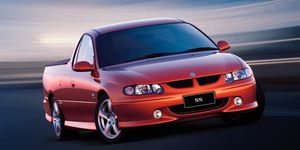It’s rare to see a major automaker “retire” a brand, as GM called the abrupt demise of Holden earlier this week. The century-old Australian brand is set to be shut down by year’s end. These types of events date back to the dark days when GM was forced to shutter Pontiac and Saturn and watch Saab struggle along. But Holden’s closure is happening in a different era for the auto industry and largely absent any great external forces, such as a worldwide economic crisis requiring government bailouts.
Instead, Holden’s demise, despite the sudden announcement, could best be described as death by a thousand cuts amid a slow-burning regional decline for its parent automaker.
While the decision to shutter the brand might have come as a surprise to those not following the Australian auto market closely, Holden production on the continent had ended about three years ago, with GM relying on its other factories in the region to produce Holden models for export to Australia and New Zealand. The move to shift production outside Australia was made back in 2017, one that indicated the brand itself was on shaky ground. But even before 2017 Holden had been on shaky ground for some time.
GM’s official statement made only a perfunctory effort to obscure the depressing nature of this event in corporate-speak, in a statement titled “GM Accelerates Transformation of International Markets.”
Given that title alone, it might have been difficult to tell it was an announcement that GM would rapidly close down a brand that has existed since the middle of the 19th century, first as a saddle-maker, and later as an automaker long considered the official ambassador of Australia’s auto industry.
“General Motors is taking decisive action to transform its international operations, building on the comprehensive strategy it laid out in 2015 to strengthen its core business, drive significant cost efficiencies, and take action in markets that cannot earn an adequate return for its shareholders,” read the opening paragraph.
But what financial considerations had led to the actual decision to close the brand by the end of the year?
GM Holden’s last boss, Kristian Aquilina, indicated to Australia’s Motoring that the investment required for a turnaround plan was too great, and the return on investment was not seen as being substantial enough to pursue.
“In this investment cycle, we developed an ambitious investment—an investment proposal to turn around our current performance and to see Holden flourish in this market, not just survive,” Aquilina told Motoring.
“And over a number of months, GM undertook an exhaustive analysis of that plan; together with our parent company we chased down every conceivable option, every strategy, every plan . . . We looked under every rock,” he added.
While it’s still difficult to get a detailed picture of the all the forces that Holden would have had to overcome, one very visible cost of maintaining Holden, even with production outside the country, was the investment required to produce right-hand-drive versions of GM vehicles for Australia’s consumption. And that’s given the likely expectation that no models would be unique to Australia — they were not unique for quite some time, in fact—with the lineup representing a mix of U.S. and Asian-market models sold under Chevrolet, GMC and Buick brands.
Motoring reports the cost of engineering right-hand-drive versions of these models would have largely fallen to Holden because it offers vehicles aimed primarily at left-hand drive markets; all models, including the Holden Acadia (GMC Acadia), Holden Commodore (Buick Insignia), Holden Equinox (Chevrolet Equinox), Holden Trailblazer (based on the Chevrolet Colorado pickup), have largely been produced in right-hand-drive form for Australia and New Zealand, but the majority of their production was aimed at other markets. Of course, merely closing Holden is also expected to cost $1.5 billion in Australian dollars.
In effect, it would have been too expensive even to offer badge-engineered, right-hand-drive versions of GM vehicles produced for other global markets.
If there is one parallel that could be made to other GM brands shuttered a decade ago it’s that by their last years they were rebadged versions of something else. If you recall, Pontiac relied on Holden models in its twilight years, Saturn models were mostly Opels/Vauxhalls, and Oldsmobiles were thinly disguised versions of other GM cars made for the U.S. market. Not even Saab escaped badge engineering, offering its own version of the Chevy TrailBlazer and Subaru Impreza. The jury is still out on which of those two made a less convincing Saab, but the last couple of years it existed, the brand managed to roll out an original-looking 9-5 and was just a couple of weeks into production of the 9-4x crossover, just a few hundred of which were produced.
Holden’s postmortem is still being written, and it’s still early to pinpoint the moment in time that was the brand’s point of no return. But it likely happened long before production had left Australia, and Holden was forced to rely on GM models manufactured elsewhere, for other markets, just as it had with other GM brands that were closed down earlier in this century.
Source: Motor - aranddriver.com









